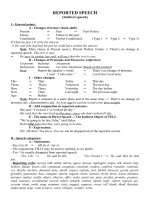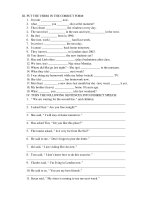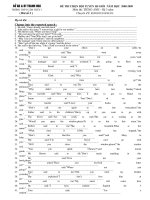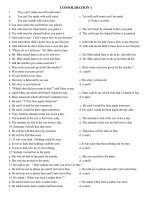REPORTED SPEECH - 11
Bạn đang xem bản rút gọn của tài liệu. Xem và tải ngay bản đầy đủ của tài liệu tại đây (72.71 KB, 3 trang )
REPORTED SPEECH - 12
Statements in reported speech:
Để đổi câu từ trực tiếp => gián tiếp cần:
1. Dùng động từ giới thiệu say or tell
Ex: He says (that) he is a student.
He told me (that) he would come back.
2. Đổi các đại từ nhân xưng, đại từ or tính từ sở hữu sao cho tương ứng với chủ ngữ
or tân ngữ của mệnh đề chính.
Ex: John said, "I am doing my homework." => John said (that) he was doing his home
work.
3. Đổi thì của động từ trong lời nói trực tiếp thành quá khứ tương đương nếu động
từ giới thiệu ở quá khứ.
Present simple => Past simple
Present progressive => Past progressive
Present perfect => Past perfect
Present perfect progressive => Past perfect progressive
Past simple => Past perfect
Past progressive => Past perfect progressive
Future simple => Future in the past
Future progressive => Future progressive in the past
Modal verbs => Modals in the past
Ex: He said,"I have seen that film". => He said (that) he had seen that film.
4. Cách đổi 1 số tính từ chỉ định và trạng từ chỉ nơi chốn, thời gian:
- this -> that
- these -> those
- now -> then
- ago -> before
- yesterday -> the day before
- tomorrow -> the following day
Ex: Peter said,"I don't like this party." => Peter said (that) he didn't like that party.
II. Questions in reported speech:
1. Yes - No questions:
Khi đổi câu hỏi Yes - No từ trực tiếp sang gián tiếp cần:
- Dùng động từ giới thiệu ask, inquire, wonder, want to know,...
- Dùng if or whether ngay sau động từ giới thiệu của mệnh đề chính.
- Đổi trật tự câu hỏi thành câu tường thuật: S + V
- Đổi đại từ, tính từ sở hữu, thì của động từ và các trạng từ chỉ thời gian, nơi chốn (giống
cách đổi trong câu tường thuật).
S1 + ask + (object) + if/whether + S2 + V
Ex: He said,"Can u go with me?" => He asked me if I could go with him.
2. WH - questions:
- Dùng các động từ giới thiệu: ask, inquire, wonder, want to know,...
- Lặp lại từ để hỏi (what, when,...) sau động từ giới thiệu.
- Đổi cấu trúc câu thành câu từong thuật: S + V
- Đổi các tính từ sở hữu, đại từ, thì của động từ và các trạng từ chỉ t/gian, nơi chốn.
S1 + ask + (O) + what/where/... + S2 + V
Ex: He said,"What time does the film begin?" => He wanted to know what time the film
began.
III. Reporting ofers, suggestions, oders, etc:
Lời hứa, đồng ý, mệnh lệnh, đề nghị, yêu cầu, khuyên... thường được tường thuật lại
bằng động từ nguyên mẫu có to (to infinitive) or tân ngữ + động từ nguyên mẫu ( O + to
infinitive)
Ex: He promised to write.
# Một số động từ được giới thiệu theo sau bởi O + to inf : advise, ask, beg, command,
compel, encourage, entreat, expect, forbid, implore, instruct, invite, order, persuade,
recommend, remind, request, tell, urge, warn.
Ex: "Don't swim out too far",I said. => I warned the bóy not to swim out too far.
# Một số động từ theo sau bởi To Inf: agree, demand, guarantee, hope, offer, promise,
propose, swear, threaten, volunteer, vow.
Ex: He said,"I'll take u to the circus". => He promised to take me to the circus.
# không dùng To Inf sau 1 số động từ như: advise, insist, order, say, suggest,
etc. Dùng that-clause.
Ex: He suggested that I try to pas the final exam.
### Một số trường hợp không thay đổi động từ trong lời nói gián tiếp:
- động từ trong mệnh đề chính ở các thì hiện tại or tương lai đơn.
Ex: He says,"I'm hungry". => He says (that) he is hungry.
- Lời nói trực tiếp diễn tả 1 chân lý or 1 thói quen ở hiện tại.
Ex: She said,"The earth moves round the sun". => She said (that) the earth moves round
the sun.
- Lời nói trực tiếp có các động từ could, would, should, might, ought to, used to, had
better (must để nguyên or đổi thành had to).
Ex: He said"You must study well" => He said (that) I had better study well.









